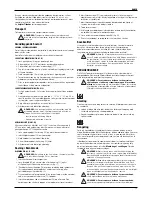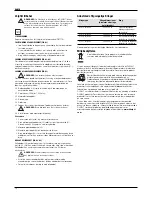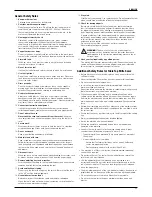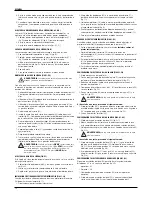
ENGLISH
27
6 Blade slot
7 Mitre lever
8 Mitre latch
9 Rotating table/mitre arm
10 Mitre scale
11 Fence
12 Bevel clamp handle
A2
13 Head lock down screw
14 Saw bench table
15 Riving knife
16 Upper saw blade guard
17 Rip fence
18 Fixed lower guard (for use in bench saw position)
19 Attachment mounting holes
OPTIONAL ACCESSORIES
A3
20 Table end plate
21 Support guide rails
22 Material support plate
23 Material clamp
24 Swivelling stop
25 Adjustable stand 760 mm (max. height)
26 Legstand
A4
27 Length stop for short workpieces (to be used with guide rails [21])
A5
26 Legstand
29 Roller table
INTENDED USE
Your DW711 table top mitre saw has been developed
for professional
cutting wood, wood poducts and plastics
. This high precision machine can
be easily and quickly set to crosscut, bevel, mitre, or compound mitre.
This unit is designed for use with a nominal ø 260 mm carbide tip blade
for professional cutting wood, wood poducts and plastics.
DO NOT
use under wet conditions or in presence of flammable liquids or
gases.
These table top mitre saws are professional power tools.
DO NOT
let children come into contact with the tool. Supervision is required
when inexperienced operators use this tool.
WARNING: Do not use this machine for purposes other
than described.
Electrical Safety
The electric motor has been designed for one voltage only. Always check
that the power supply corresponds to the voltage on the rating plate.
Machines in the scope of EN 61029 are not allowed for production use.
In case of cord replacement the tool must only be repaired by an authorized
service agent or by qualified electrician.
Mains Plug Replacement
(U.K. & Ireland Only)
If a new mains plug needs to be fitted:
• Safely dispose of the old plug.
• Connect the brown lead to the live terminal in the plug.
• Connect the blue lead to the neutral terminal.
• Connect the yellow/green lead to the earthing terminal.
Follow the fitting instructions supplied with good quality plugs.
Recommended fuse: 13 A.
FITTING A MAINS PLUG TO 115 V UNITS
The plug should be fitted by a competent person. If you are in doubt,
contact an authorized D
E
WALT repair agent or qualified electrician.
The plug fitted should comply with BS EN 60309 (BS4343), 16 Amps,
earthing contact position 4h.
Using an Extension Cable
If an extension cable is required, use an approved extension cable suitable
for the power input of this tool (see technical data). The minimum conductor
size is 1.5 mm
2
; the maximum length is 30 m.
When using a cable reel, always unwind the cable completely.
Assembly and Adjustment
WARNING: To reduce the risk of injury, turn unit off and
disconnect machine from power source
before installing
and removing accessories, before adjusting or changing set-
ups or when making repairs. An accidental start-up can cause
injury.
MOUNTING THE UPPER GUARD (FIG. B)
1. Fasten the guard (16) to the riving knife (15) with the bolt (32), bushing
and nut.
2. Place the bushing through riving knife and guard. Slide bolt (32) through
bushing and fasten with nut. Tighten securely. Ensure flaps (31) on
guard are positioned as shown.
MOUNTING AND ADJUSTING THE RIP FENCE (FIG. C1–C4)
The rip fence consists of a fixed and a sliding fence.
1. Loosen the fence support locking knob (34) which holds the clamping
plate inposition (fig. C1).
2. Slide the fence onto the front of the table using the U-shaped slot as
the guide (fig. C2, C3).
3. Slide the fence towards the blade and tighten the locking knob.
4. Check that the fence is parallel to the blade.
5. If adjustment is required, proceed as follows:
6. Loosen the sliding fence locking knob (35) (fig. C1) and slide the sliding
fence backwards in order to obtain full sight on the two holes (36)
(fig. C4) in the top of the fence.
7. Using the small hex key, loosen the two hex screws fastening the fence
to the fence support. Access is gained through the two holes in the top
of the fence.
8. Adjust the fence so that it is parallel to the blade by checking the
distance between the blade and the fence at the front and rear of the
blade.
9. When the adjustment has been carried out, re-tighten the hex screws
and check again that the fence is parallel to the blade.
ADJUSTING THE SAW BENCH TABLE (FIG. A2, B, D)
The table (14) slides up and down manually and is held at the required
height with two locking knobs.
1. Loosen the table locking knobs, both main (37) (fig. D) and additional (3)
(fig. A1), but do not take them off.
2. Set the table to the proper height needed.
3. Tighten the table locking knobs (fig. A1, D).
REMOVING THE SAW BENCH TABLE (FIG. B)
The table can be removed to gain access to the saw blade.
1. Remove the upper blade guard (16) (fig. B).
2. Loosen the table locking knobs, both main (37) (fig. D) and additional (3)
(fig. A1), but do not take them off.
3. Use the hex key to remove the screw (38) from the rear table column
(fig. D). Take the nut and washer off the other end of the screw.
4. Remove the table.
5. To replace the table, proceed in reverse order.
MOUNTING THE SAW BLADE (FIG. E1–E5)
WARNING:
The teeth of a new blade are very sharp and can
be dangerous.
Summary of Contents for DW711
Page 1: ...www eu DW711 ...
Page 3: ...1 A1 A2 11 12 2 1 5 3 4 7 8 6 10 9 14 17 19 18 58 13 16 15 ...
Page 4: ...2 25 25 20 21 22 23 21 22 20 26 24 27 21 26 29 32 30 31 15 35 34 36 A3 A5 C1 C3 A4 B C2 C4 16 ...
Page 5: ...3 10 47 38 37 41 40 43 39 4 42 44 45 46 40 7 8 9 D E2 E4 F1 E1 E3 E5 F2 41 ...
Page 6: ...4 43 11 48 49 49 12 12 43 48 50 51 53 52 53 54 12 55 51 F3 G1 G3 H1 F4 G2 G4 H2 ...
Page 7: ...5 2 mm 5 mm 15 57 59 58 I1 J1 K M I2 J2 L N 60 11 18 13 2 9 ...
Page 8: ...6 O P A ...
Page 9: ...7 Q1 61 18 14 62 Q2 ...
Page 114: ...112 ...
Page 115: ...113 ...
















































